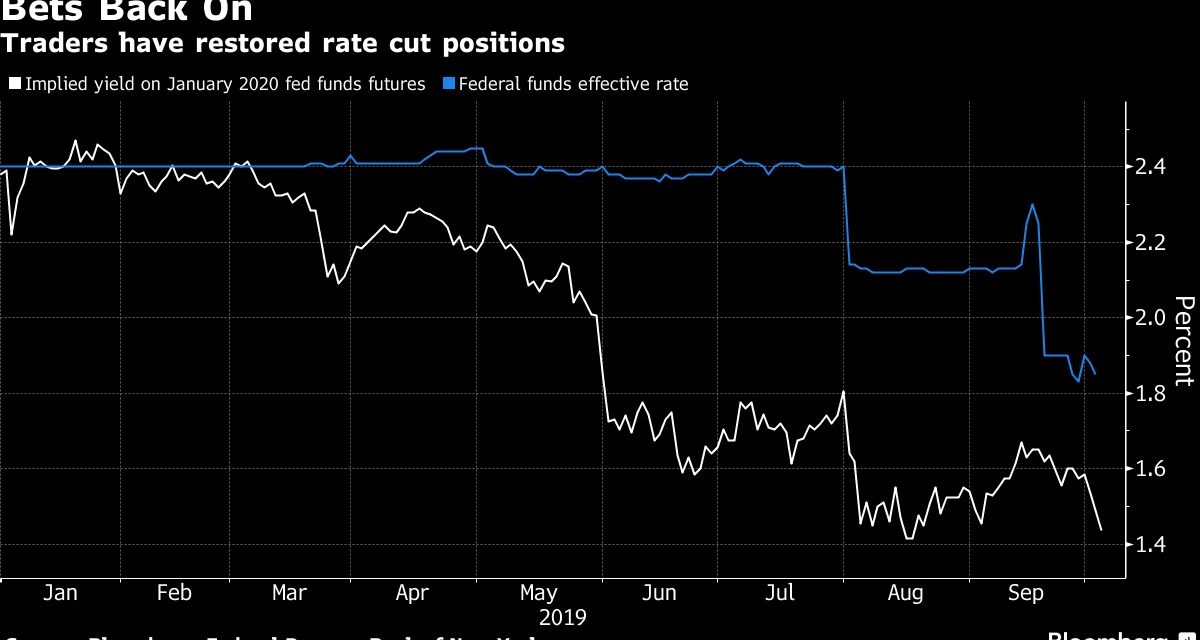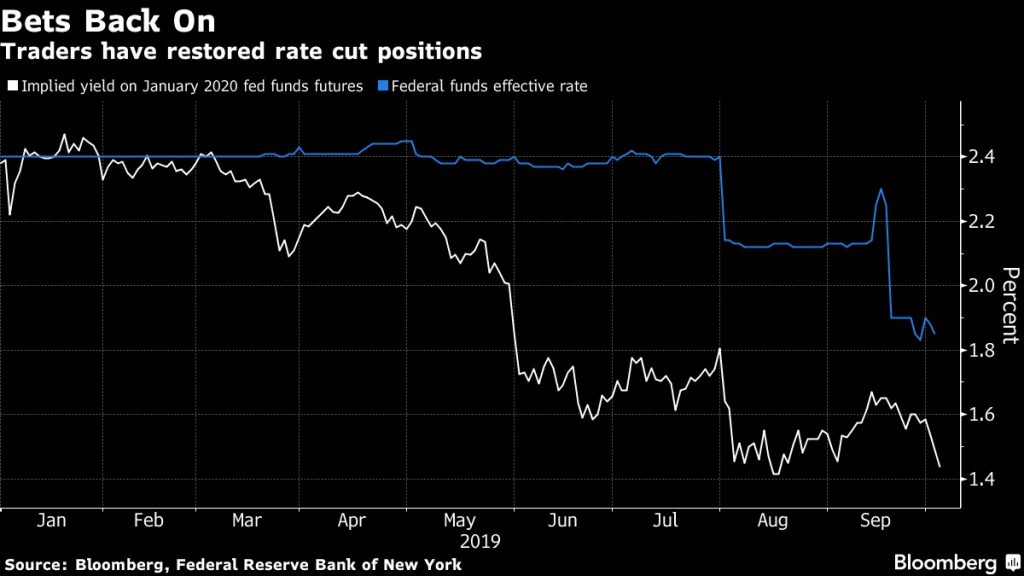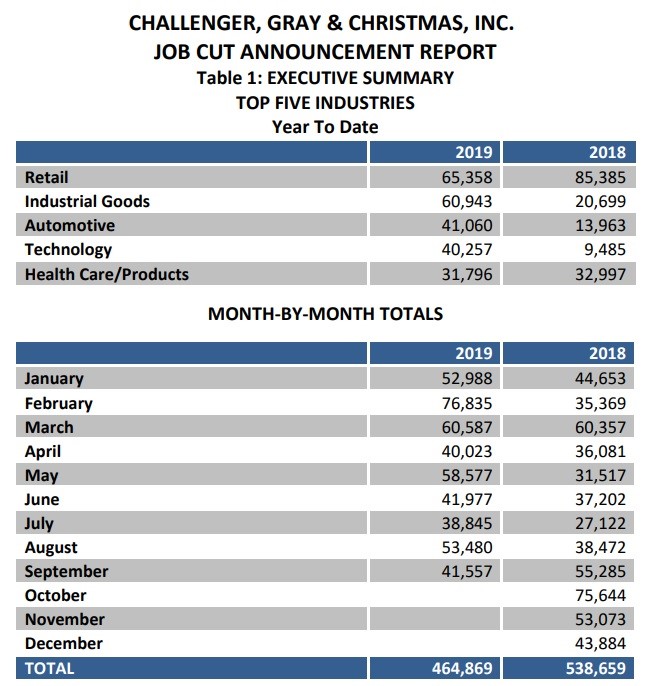UPFINA's Mission: The pursuit of truth in finance and economics to form an unbiased view of current events in order to understand human action, its causes and effects. Read about us and our mission here.
Reading Time: 4 minutes
The S&P 500 fell over 1% in the minutes following the disappointing non-manufacturing ISM PMI report on Thursday. Unlike the reaction to the disappointing manufacturing PMI, stocks recovered quickly because the odds of rate cuts increased. This is yet another example of stocks rallying on bad news because the Fed can help it out. This led some to sarcastically remark that a few more bad reports can get the market to a new record high. To be fair, stocks also were oversold according to the equity only put to call ratio. The change in the Fed funds futures market certainly played a role in the rally.
Two More Rate Cuts In 2019?
Over the past few trading days, the market went from seeing a rate cut in December, to seeing one in October, to potentially seeing one at both meetings. The chart below shows the recent decline in the implied yield on January 2020 Fed fund futures.
There is now a 79.6% chance of a rate cut at the October 30th meeting. One week prior there was a 49.2% chance of a cut. Usually, the market locks in rate decisions a couple weeks before the decision; over a 70% chance means the decision is very likely.
The Fed funds futures market will likely be altered by how the US China trade negotiations go. If they go well, there will be a lower chance of a cut and if they go poorly, there will be a higher chance of a cut. The Fed’s blackout window, which is when members can’t discuss policy publicly anymore, starts on October 19th. The odds of two more cuts this year are 43.5%. That’s up from 20.3% a week ago. If the Fed cuts rates four times in 2019, it clearly sees a significant risk of a recession or a sharp slowdown. In recent years, the Fed has been quick to cut rates and slower to raise them. It’s noteworthy to point out that many have argued that the Fed is behind the curve in cutting rates based on interest rate differentials.
Big Decline In ISM Non-Manufacturing PMI
The September ISM services PMI fell even more than the manufacturing PMI. As you can see from the chart below, it fell from 56.4 to 52.6 which missed estimates for 55.5 and the low end of the expected range which was 54.
As the chart shows, it needs to fall below 48.6 to signal a recession which means it isn’t near there yet. This report is consistent with 1.4% GDP growth which is near the manufacturing report’s 1.5% equivalence.
The services report showed much more sequential weakness because its production index fell 6.3 points to 55.2. 13 industries reported increases and two reported decreases. This is a broad based slowdown without many laggards. The big difference from the sequential change in the manufacturing report was that service sector new orders fell 6.6 points to 53.7. 4% more firms stated there were lower new orders. Just like manufacturing, the prices index increased as it was up 1.8 to 60. Despite the trade war, export orders increased 1.5 to 52.
Since the service sector employs most workers, its employment reading is critical. As the chart below shows, it fell 2.7 points to 50.4. Its lowest reading this cycle was in February 2014 when it hit 48.4.
The index only needs to fall slightly more than 5 points to hit the 2001 recession low. Just like in the manufacturing report, three of the firms quoted mentioned the impact of the trade war. An accommodation and food services firm stated, “Tariffs are adding uncertainty to short-term pricing on certain commodities, but suppliers are finding alternate solutions. The bigger impacts appear to be on demand side, which is driving short-term favorability in certain domestic markets.”
Markit Services PMI Also Weak
Just like the Markit manufacturing PMI, the Markit services PMI increased. The PMI was up from 50.7 to 50.9 which put the composite at 51 (up from 50.7). As the charts below show, the difference in relation to the ISM report is that the Markit services PMI was below the ISM PMI.
At the end of the previous two recessions, the manufacturing Markit PMI was above the ISM PMI. The Markit services PMI has been consistently below its ISM counterpart.
The details of the Markit services PMI were awful. New orders growth was the lowest in the near 10 year history of this survey. The decline in new export orders was the worst since the survey started in 2014. Just like the ISM report, employment was weak. It contracted for the first time since February 2010 and workforce numbers fell the most since late 2009. Service sector backlogs were the worst since April 2014. Expectations improved slightly, but the index was still the 2nd worst in history. The composite PMI was consistent with just 1.5% GDP growth and less than 100,000 jobs added.
Good Labor Reports
Despite those negative employment readings, in the week of September 28th, jobless claims were only 219,000. As the table below shows, in September job cut announcements fell to 41,557 from 53,480, making this the 2nd lowest number of job cuts in 2019. Year to date job cuts (highest since 2015) were up 27.9% mainly because cuts were high in the first three months of the year.
Tariffs have caused 2,458 job cuts in 2019 which is just 0.5% of the total. Retail saw a decline in cuts from 85,385 to 65,358, but cuts might increase in October because of Forever 21’s bankruptcy. Industries impacted by the global slowdown such as industrial goods, automotive, and technology have seen huge increases in job cuts from last year. The highest ever year for job cuts (since 1989) was 1.957 million in 2001.
Conclusion
The market started pricing in two more rate cuts in 2019, bringing the potential total to four cuts in 2019. The declines in both ISM reports pushed the futures market towards expecting more cuts. New orders and production plummeted in the service sector. Just because the Markit services PMI rose, doesn’t mean this was a good report. It was very bad as it is consistent with less than 100,000 jobs created and 1.5% GDP growth. On the other hand, jobless claims are very low and job cut announcements in September were the 2nd lowest in 2019.
Have comments? Join the conversation on Twitter.
Disclaimer: The content on this site is for general informational and entertainment purposes only and should not be construed as financial advice. You agree that any decision you make will be based upon an independent investigation by a certified professional. Please read full disclaimer and privacy policy before reading any of our content.













